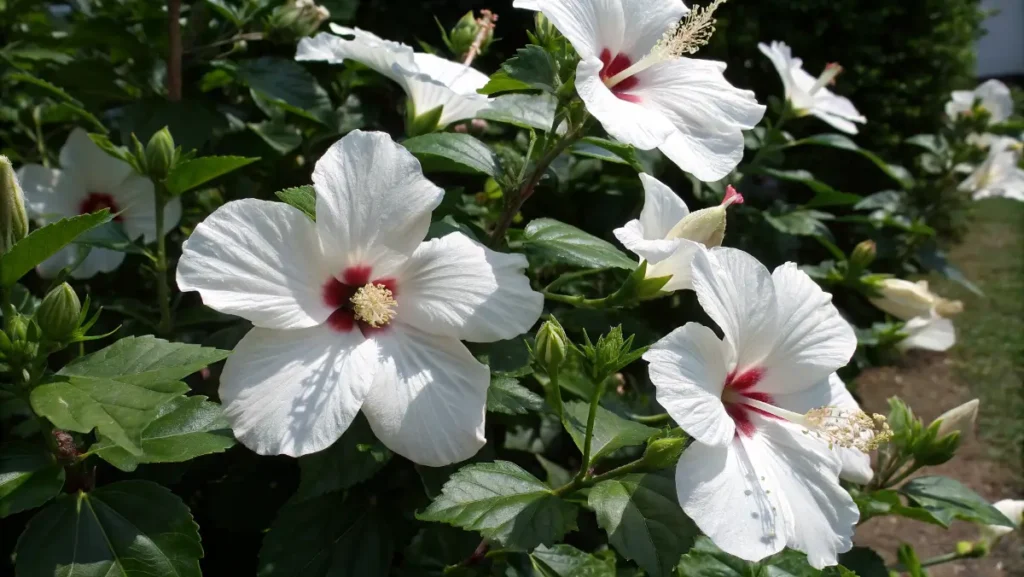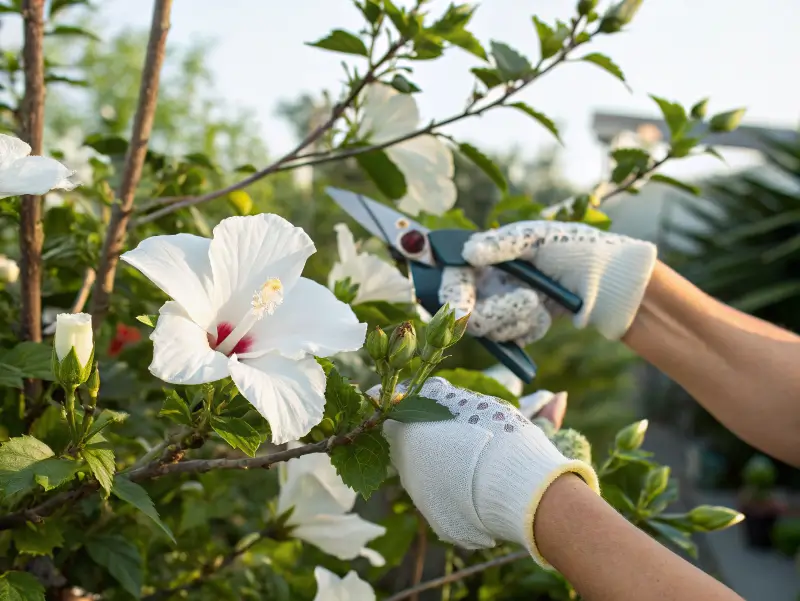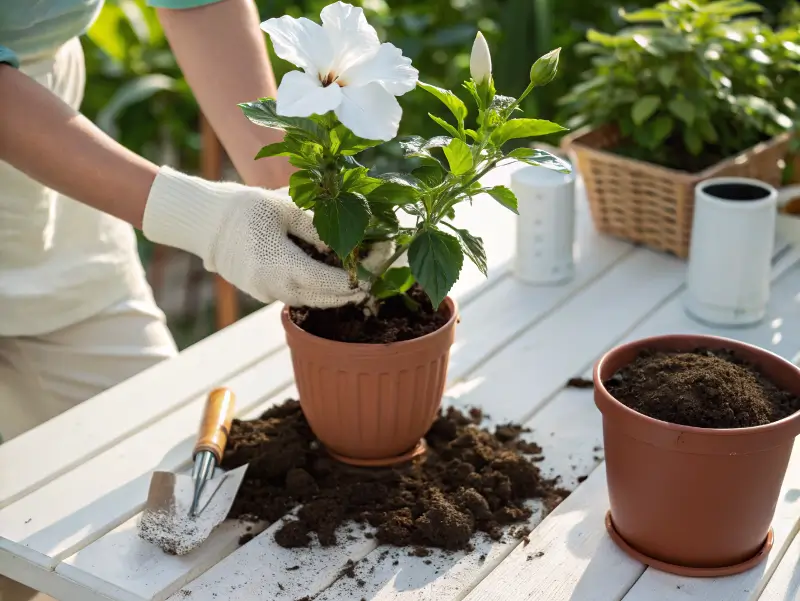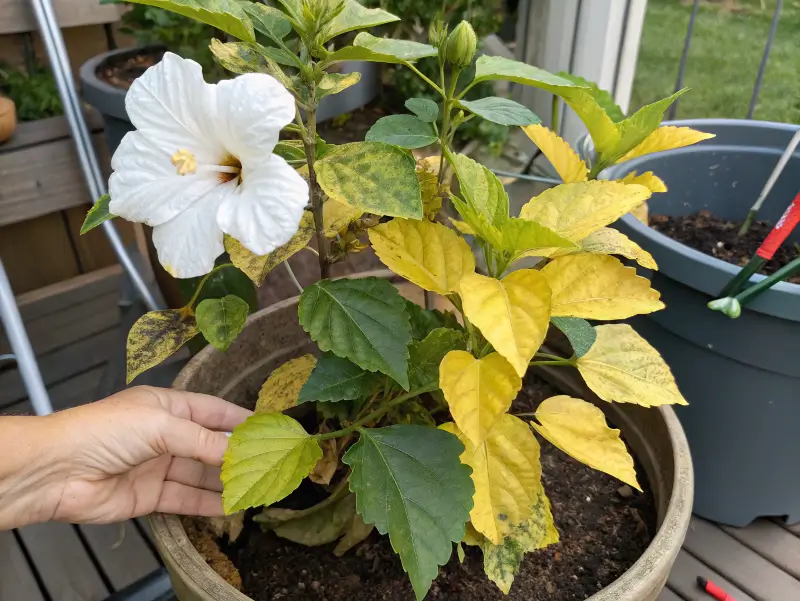
In This Article
White hibiscus flower (Hibiscus rosa-sinensis) is a showstopping tropical beauty famous for its stunning papery white blooms and glossy green leaves. These fast-growing shrubs reach 4-8 feet tall, creating gorgeous focal points in any garden. They love bright morning sun and consistent moisture but are surprisingly easy to care for. While generally safe around pets, it’s best to keep curious nibbles away. You’ll absolutely love their silky petals and tropical charm!
White Hibiscus Flower Care
Let’s face it – caring for these beauties isn’t rocket science, but there are definitely some tricks that’ll help you succeed. I’ve been growing white hibiscus flower varieties for years, and trust me, once you get the basics down, you’ll be rewarded with blooms that’ll take your breath away.
Light Requirements
Your white hibiscus flower needs bright light to produce those stunning blooms we all love. These plants absolutely love bright light – think 6-8 hours of morning sun with some afternoon protection. If you’re growing them indoors, place them near your brightest south-facing window.
Here’s what I’ve learned the hard way: too much harsh afternoon sun can actually scorch those delicate white petals. Meanwhile, insufficient light means fewer blooms and leggy growth. You’ll know your white hibiscus flower is happy when new buds keep forming and the leaves stay that gorgeous deep green color.
Watering Guidelines
Watering hibiscus is all about finding that sweet spot between “tropical rainforest” and “desert wasteland.” These plants love consistent moisture but hate soggy feet – kind of like that friend who wants attention but not too much!
During growing season (spring through fall), water when the top inch of soil feels dry. In summer, this might mean daily watering for container plants. However, winter is different – reduce watering significantly since the plant’s growth slows down.
Pro tip: Water deeply but less frequently rather than little sips every day. Your white hibiscus flower will develop stronger roots this way and produce more vibrant blooms.
Soil Preferences
The perfect soil for white hibiscus flower cultivation is like a good chocolate cake – rich, well-draining, and slightly acidic. Aim for a pH between 6.0-6.8 for optimal nutrient uptake and maximum white hibiscus flower production.
For container growing, I swear by a mix that’s equal parts:
- Quality potting soil
- Perlite or coarse sand
- Compost or aged manure
If you’re planting in the ground, work in plenty of organic matter. Sandy loam is ideal, but honestly, most soils work fine with some amendments.
Temperature and Humidity
White hibiscus plants are tropical divas when it comes to temperature. They absolutely thrive in temperatures between 65-80°F during the day and prefer nights that don’t drop below 50°F.
Humidity is where things get interesting. These plants love humidity levels around 50-60%. If you’re in a dry climate, try grouping plants together or using a humidity tray. Just don’t mist the flowers directly – water spots on those pristine white hibiscus flower petals are not a good look!
Fertilizer Needs
Feeding your hibiscus is like feeding a teenager – they need regular, balanced nutrition to keep growing and blooming. During the active growing season, fertilize every 2-3 weeks with a balanced liquid fertilizer to encourage more white hibiscus flower development.
Look for fertilizers with an N-P-K ratio around 10-10-10 or 20-20-20. However, if you want maximum blooms, switch to a high-phosphorus fertilizer during flowering season. Organic options like compost tea or fish emulsion work wonderfully too.
White Hibiscus flower Varieties and Types
The world of white hibiscus flower varieties is absolutely fascinating! There’s way more diversity than most people realize, and each type has its own personality. When planning your garden color scheme, you might also consider other flowering plants like Yellow Chrysanthemum to create stunning contrast with your white blooms.
Popular White Cultivars
‘Snow Queen’ is probably my favorite – pure white blooms that are absolutely pristine. The flowers are large, single, and have this amazing papery texture that catches light beautifully.
‘White Wings’ offers something different with white petals and a dramatic red center. It’s like nature decided to add a pop of color right in the middle! This variety tends to be more compact, making it perfect for containers.
‘Diana’ is the hardy hero of the white hibiscus world. This variety can actually survive in colder climates and comes back year after year in zones 5-9.
Single vs Double Blooms
Single blooms are classic and elegant – they’re what most people picture when they think “hibiscus.” These white hibiscus flower types typically last 1-2 days but are produced continuously during the growing season.
Double blooms, on the other hand, look like white roses had a baby with a hibiscus! They’re absolutely stunning but tend to be less heat-tolerant and may not bloom as prolifically.
Hardy vs Tropical Varieties
This is crucial to understand, especially if you live somewhere that gets cold winters. Tropical hibiscus (like most white hibiscus flower varieties) are perennials in warm climates but need protection or indoor growing in colder areas.
Hardy white hibiscus flower varieties can survive freezing temperatures and will die back to the ground in winter, then return in spring. They’re perfect for gardeners in northern climates who want that tropical look without the fuss.
Pruning

Pruning might seem scary at first, but honestly, white hibiscus flower plants are pretty forgiving. I remember being terrified to cut my first hibiscus, but now I look forward to pruning season!
When to Prune
The best time for major pruning is late winter or early spring, just before new growth begins. This timing gives your plant the entire growing season to recover and produce new blooms.
However, don’t be afraid to do light pruning throughout the growing season. Deadheading spent white hibiscus flower blooms actually encourages more flowers, and removing any dead or damaged branches can be done anytime.
Pruning Techniques
For deadheading, simply pinch or cut off spent white hibiscus flower blooms just above the next leaf node. This redirects the plant’s energy into producing new buds instead of setting seeds.
When doing major pruning, you can actually cut hibiscus back by up to one-third of its size. Make cuts just above outward-facing buds to encourage an open, airy growth pattern. Sharp, clean tools are essential – I always clean my pruners with rubbing alcohol between plants.
Remember: New growth produces the most flowers, so don’t be afraid to prune for shape and size control.
Tools and Safety
You’ll need sharp bypass pruners for most cuts and maybe loppers for thicker branches. Always wear gloves because some people are sensitive to hibiscus sap.
Clean your tools between plants to prevent disease spread. A quick wipe with rubbing alcohol does the trick perfectly.
Propagating White Hibiscus Flower
Propagating white hibiscus flower plants is one of my favorite gardening activities – there’s something magical about creating new plants from existing ones! Plus, it’s a great way to share these beauties with friends and family.
Stem Cutting Method
This is by far the easiest and most successful method for white hibiscus flower propagation. Take 4-6 inch cuttings from healthy, non-flowering shoots in late spring or early summer. Make sure each cutting has at least 3-4 leaf nodes.
Remove the bottom leaves and dip the cut end in rooting hormone (though it’s not absolutely necessary). Plant in a mix of perlite and peat moss, keep consistently moist, and provide bright, indirect light.
Most cuttings root within 4-6 weeks. You’ll know they’re ready when you see new growth appearing at the tips!
Air Layering Technique
This method is perfect for larger, more established plants. Choose a healthy branch and make a small wound in the bark about 12 inches from the tip. Wrap the wounded area with moist sphagnum moss and cover with plastic wrap.
Air layering takes longer (2-3 months) but has a higher success rate, especially for harder-to-root varieties.
Seed Propagation
Growing white hibiscus flower plants from seed is possible but requires patience. Hibiscus seeds need warm temperatures (75-85°F) and consistent moisture to germinate. However, plants grown from seed may not be true to the parent plant’s characteristics.
Soak seeds overnight before planting, and expect germination in 1-3 weeks under ideal conditions.
Potting and Repotting White Hibiscus Flower

Container growing is fantastic for white hibiscus flower plants, especially if you need to bring them indoors during winter. I’ve had great success with potted hibiscus, and they actually bloom more prolifically when slightly root-bound!
Container Selection
Choose pots with excellent drainage – this cannot be overstated! Terra cotta pots are great because they’re porous and help prevent overwatering. However, plastic pots work fine too and retain moisture longer.
Size matters here. Start with a pot that’s 2-3 inches larger than the root ball. Going too big too fast can actually lead to overwatering issues.
Potting Mix Requirements
A good commercial potting mix works perfectly, but I like to add extra perlite for drainage. The mix should hold moisture but drain freely – think “wrung-out sponge” consistency.
Avoid garden soil in containers as it’s too heavy and doesn’t drain well. Your white hibiscus flower roots need air circulation to stay healthy and produce those gorgeous blooms.
Repotting Schedule
Most hibiscus need repotting every 2-3 years, or when roots start growing out of drainage holes. Spring is the ideal time for repotting, just as new growth begins.
When repotting, gently tease apart any circling roots and trim off any that look brown or mushy. Fresh soil will give your plant a nice boost for the growing season.
Common Pests and Diseases
Even the most well-cared-for plants can face pest and disease issues. The good news is that most hibiscus problems are totally manageable with early intervention. For comprehensive pest management strategies, the USDA’s Integrated Pest Management guide provides excellent resources for home gardeners.
Frequent Pest Issues
Aphids are probably the most common pest I encounter on hibiscus. These tiny green or black insects cluster on new growth and flower buds. A strong spray of water often dislodges them, or you can use insecticidal soap.
Spider mites love hot, dry conditions and create fine webbing on leaves. Increase humidity and use predatory mites or miticide sprays for severe infestations.
Whiteflies look like tiny white moths and fly up when you disturb the plant. Yellow sticky traps work great for monitoring and controlling small populations that might damage your white hibiscus flower display.
Disease Prevention
Most hibiscus diseases are fungal and related to too much moisture on leaves. Water at soil level rather than overhead, and provide good air circulation around plants.
Leaf spot diseases show up as brown or black spots on leaves. Remove affected foliage immediately and avoid getting water on leaves during watering.
Root rot is the most serious issue and usually results from overwatering or poor drainage. Prevention is key here – proper soil and watering practices are your best defense.
Common Growing Issues with White Hibiscus Flower
Let’s be real – every hibiscus grower faces challenges sometimes. I’ve dealt with most of these issues myself, and the solutions are usually simpler than you’d expect! If you’re also growing other flowering plants like Red Chrysanthemum, you’ll find many of these troubleshooting tips apply across different flower varieties.
Yellowing Leaves

Yellow leaves are probably the most common complaint I hear about hibiscus. Usually, it’s either overwatering, underwatering, or natural aging of older leaves.
Check your watering schedule first. If the soil is soggy, cut back on water. If it’s bone dry, increase watering frequency. Sometimes it’s just the plant dropping older leaves to make room for new growth – totally normal!
Nutrient deficiencies can also cause yellowing. A balanced fertilizer usually solves this problem within a few weeks.
Poor Flowering
Nothing’s more frustrating than a white hibiscus flower that won’t bloom! Usually, this comes down to insufficient light or too much nitrogen fertilizer affecting white hibiscus flower production.
Make sure your plant gets at least 6 hours of bright light daily. If you’ve been feeding with high-nitrogen fertilizer, switch to a balanced or high-phosphorus formula to encourage blooming.
Age matters too – young plants may take a full season to start blooming regularly.
Leaf Drop Problems
Sudden leaf drop often indicates environmental stress. Changes in watering, temperature, or light can trigger this response. Don’t panic – hibiscus are surprisingly resilient!
Keep conditions as consistent as possible, and your plant should recover within a few weeks. This is especially common when bringing outdoor plants indoors for winter.
Frequently Asked Questions
How rare is a white hibiscus?
White hibiscus aren’t particularly rare, but they’re definitely less common than red or pink varieties in most garden centers. You might need to special order them or visit specialty nurseries. Online retailers usually have the best selection of white hibiscus flower varieties.
What does the white hibiscus flower symbolize?
White hibiscus flowers traditionally symbolize purity, new beginnings, and spiritual enlightenment in many cultures. In Hawaiian culture, they represent rare beauty and delicate charm. They’re often used in wedding arrangements for their pure, elegant appearance.
What are the benefits of white hibiscus flowers?
Besides their obvious ornamental value, hibiscus flowers (including white varieties) are edible and make excellent herbal teas. They’re rich in vitamin C and antioxidants. The white hibiscus flower also attracts beneficial pollinators like butterflies and hummingbirds to your garden.
What is the white hibiscus called?
White hibiscus varieties go by several names depending on the specific cultivar. Common names include Snow Queen hibiscus, White Wings hibiscus, or simply white tropical hibiscus. The scientific name is typically Hibiscus rosa-sinensis followed by the cultivar name.
Growing white hibiscus flowers is honestly one of the most rewarding gardening experiences you can have. These tropical beauties bring elegance and exotic charm to any space, whether you’re growing them in containers on a patio or as landscape specimens in warm climates.
The key to success is understanding their basic needs: bright light, consistent moisture, good drainage, and regular feeding during the growing season. With proper care, you’ll be rewarded with continuous blooms throughout the warm months.

2 thoughts on “White Hibiscus Flower: Complete Care & Growing Guide”
Comments are closed.